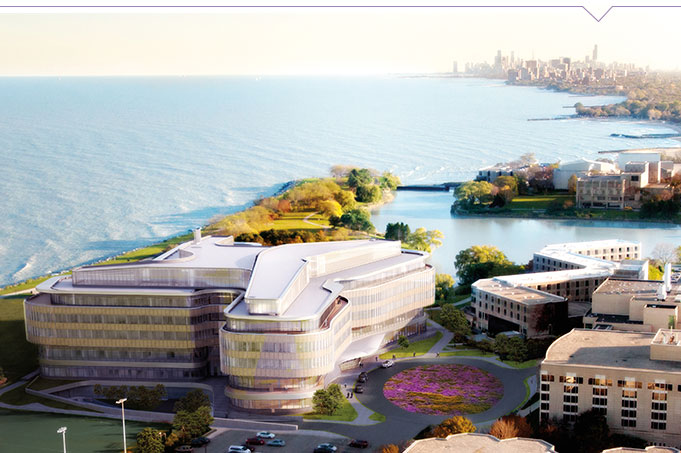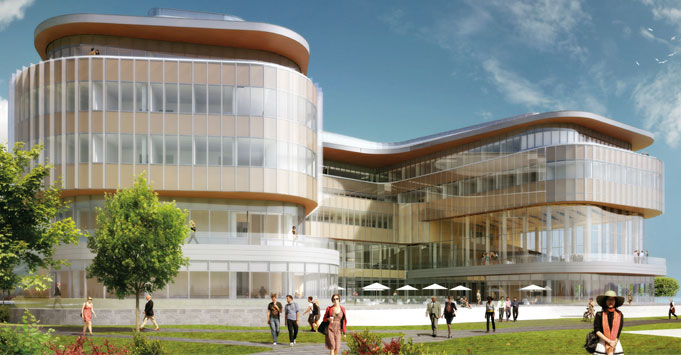
New Ground
Much like the school's strategic plan, Kellogg's planned Global Hub is an audacious undertaking.
By Glenn Jeffers | Renderings by The Flat Side of Design
The announcement came the morning of Feb. 6, 2012. A press release landed in inboxes. A new website explained it. The world was changing. And Kellogg would usher in this paradigm shift with its new strategy: "Envision Kellogg."Within hours, stories were up on the business news sites — The Wall Street Journal, Crain's, BusinessWeek. Poets & Quants, a popular blog on business-school education, gave it two pages, focusing on the school's new direction, its change in philosophy, a new matrix that connects departments over four key initiatives. Lost in the rush was the plan for a new building, one that wasn't even on paper yet.
This month, ground will break on Kellogg's new lakefront headquarters, a five-story approximately 410,000-square-foot "global hub" located northeast of the Allen Center. The completed building will house all six of Kellogg's academic departments, its four overarching, strategic research initiatives, 78 new seminar, study and classrooms, and Weinberg College's department of economics.
Standing at the northern end of the Evanston Campus lagoon, the building will offer stunning views of Lake Michigan to the north and east, and downtown Chicago to the south. But the hub's greatest asset will be its ability to foster meaningful conversations among students, faculty and the business world at large.
This is the story of a building that started with nothing more than an idea, a conversation …
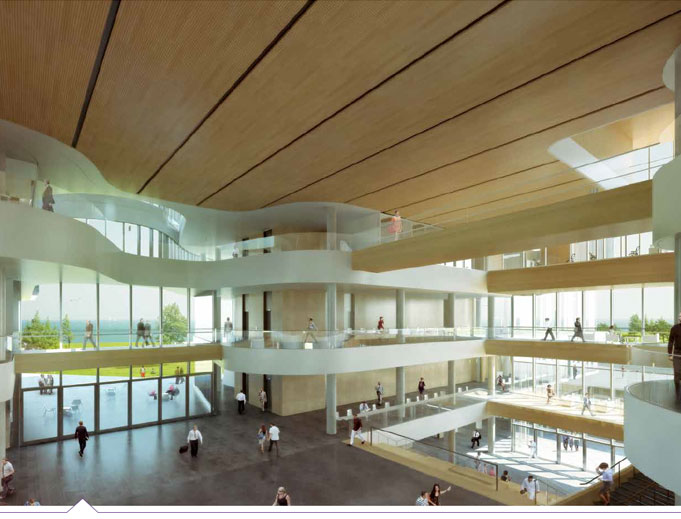 The building’s central meeting point, the 6,000-square-foot Collaboration Plaza, will welcome visitors to the heart of our campus. A pair of 34-foot-wide stairs, reminiscent of Rome’s Spanish Steps, will offer the Kellogg community a place to gather and discuss.
The building’s central meeting point, the 6,000-square-foot Collaboration Plaza, will welcome visitors to the heart of our campus. A pair of 34-foot-wide stairs, reminiscent of Rome’s Spanish Steps, will offer the Kellogg community a place to gather and discuss. It's no secret that business schools are in the midst of a building boom. Since 1999, several top-ranked schools have either added to existing facilities or built new ones outright.
Ultimately, the decision came down to a go/no-go decision to build its new hub on a lot adjacent to the Allen Center rather than build another addition to the Jacobs Center. "In Evanston, especially because of the weather, students go to school and are often locked up in [a] building all day — socializing, studying, collaborating," says Stacy Blackman '99, who covers MBA admissions for U.S. News & World Report. "Having the right setting for all of this activity is important."
With the location settled, the conversation turned to the building itself. Dean Sally Blount '92 tasked New York-based consulting firm Booz & Co. with finding out what students, faculty and administrators wanted in a new school. For the job of managing the project, Blount turned to Dennis Hareza, Kellogg's chief financial and administrative officer.
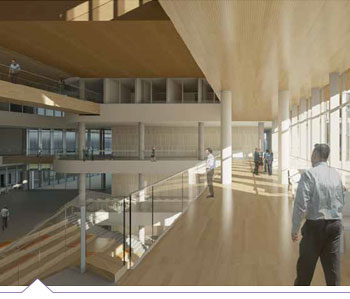
Terraces surrounding the Collaboration Plaza will provide an ideal setting for reflection, casual conversations and evening gatherngs.
A fireplace lounge, located in the southwestern corner of the first floor, will offer students a place to rest, eat and study.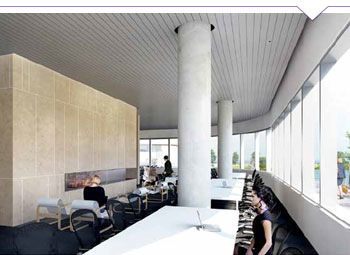
Hareza reached out to LeAnn Paul, a local architect and project consultant. An obvious choice, Paul managed the design and construction of the University of Chicago Lab School. "She's been through this before," Hareza says. "She's dealt with architects, she's dealt with faculty, she's dealt with all the nuances of building a new state of the art academic building."
Joined by Ron Nayler, associate vice president of facilities management at Northwestern, and Gordon Segal '60, a co-founder of the home décor and furniture giant Crate&Barrel, Hareza and Paul begin their search for a design firm. The group narrowed an initial list of 40 architectural firms down to 17 before selecting five in the spring of 2011, including Bohlin Cywinski Jackson, Kohn Pedersen Fox Associates, Pelli Clarke Pelli Architects, and Adrian Smith + Gordon Gill Architecture, a local firm that, among other things, designed the Burj Khalifa — the world's tallest building — in Dubai.
The fifth was Kuwabara Payne McKenna Blumberg, otherwise known as KPMB Architects. The firm had just finished expanding the University of Toronto's Rotman School of Management and was working on a job in Minneapolis. "I think our name just came up," says Marianne McKenna, one of KPMB's founding parters and project director on the building. "We were in a pretty high-powered pack of U.S. architects. We were definitely the dark horse."
Around that time, Aniruddha "Onny" Chatterjee '12 found an interesting note in his inbox. The email called for students to help create a profile of Kellogg from a cultural standpoint, providing the architects with an idea of what students wanted out of their school.
With a background in design and a love of architecture, Chatterjee was hooked. He replied and soon became one of three students chosen to work on the Booz team. "There are so many opportunities to participate in clubs and leadership activities," said Chatterjee, who now works as a marketing manager for medical tech company Becton Dickinson near Boston. "But there are few opportunities to create something that will last 40 or 50 years."
The team interviewed more than 100 students, faculty, administrative staff and alumni. Some of the questions focused on the Jacobs Center: What worked? What didn't? Other questions took a broader stance: How do you define Kellogg? What makes Kellogg unique among other business schools? Is Kellogg living up to its promise?
Aniruddha “Onny” Chatterjee '12
The student responses were thoughtful, Chatterjee says, and they aligned with the insight of Blount and the senior leadership team. Students wanted the kind of school where people could stop in the hallways and talk. And they wanted the new building to have open space similar to the atrium in Jacobs. "You walk in," Chatterjee says, "and there is a sense of a vibrant atmosphere because of the activity you see all the time."
The team traveled across the country, visiting companies like Google, IDEO and Facebook, places that would inspire Kellogg students to work and think and collaborate, says Surbhi Martin '10, one of the consultants from Booz & Co.
After nearly 20 site visits, the answers and observations boiled down to one prevailing point. "Nobody said, 'Let's have a gleaming shining tower that's going to make us feel like there's too much space and we're two rooms from each other,'" Martin says. In fact, she heard something else. "How do we keep what's good in the culture in the new building?"
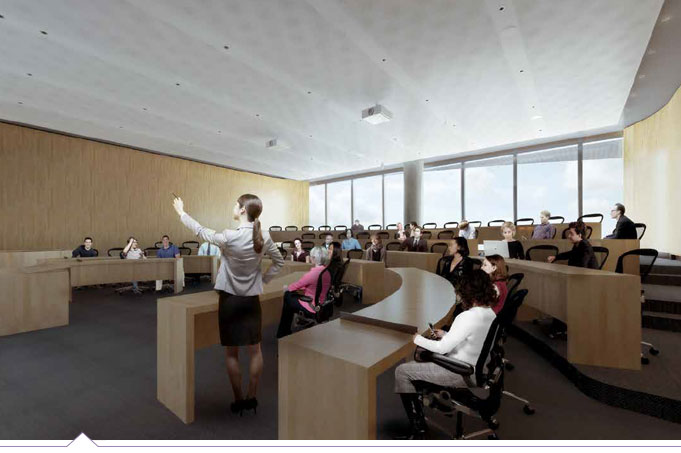 Tiered classrooms designed to foster collaboration through small-scale lectures can be reconfigured into flat spaces that can accommodate more spontaneous interaction and creative group work.
Tiered classrooms designed to foster collaboration through small-scale lectures can be reconfigured into flat spaces that can accommodate more spontaneous interaction and creative group work.The first time he visited the Evanston Campus, Bruce Kuwabara stopped by the parking lot northeast of the Allen Center. He walked across the field to the east and up to the shoreline. Below him were slabs of concrete and rock, worn down to a smooth finish by decades of crashing waves, reinforcing the shore. "I just thought, 'That's what happens when you're on a site like this,'" he recalls. "The form is really morphing. It's really changing."
As KPMB's lead design architect, the site was his, a prize the firm won after six months of grueling competition. By many accounts, KPMB was the unanimous choice for two reasons. First, Hareza says, they were great collaborators. "The two lead architects — Bruce and Marianne — really had the vision and the type of personalities and skills that could give physical expression to Kellogg's unique spirit."
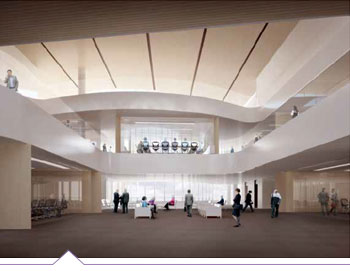
The intellectual soul of Kellogg’s new global hub, the Faculty Summit, is a 9,000-square-foot, two-story piazza that will allow faculty to discuss, debate and find solutions to the most pressing economic, business and social issues of the day.
The building’s natural palette — glass, polished steel, limestone and wood — will seamlessly merge with the sunlight shimmering off Lake Michigan, the surrounding limestone of the Northwestern campus and the placid distant views.
Second, they were the only firm that didn't include a five- to six-story atrium, which would have given the building a vast emptiness during its quieter moments.
Rather than an atrium, Kuwabara imagined four loft buildings connected by a ceiling that tops out at the third floor, creating the Collaboration Plaza, a 6,000-square-foot central atrium. Huge stairs, 34 feet wide and reminiscent of Rome's Spanish Steps — "ginormous," he calls them — would create an almost cathedral-like space, perfect for gathering and discussion. Exterior glass walls would keep the plaza awash in daylight.
On the fourth and fifth floors, faculty departments would merge into a two-story piazza, currently known as the Faculty Summit, creating what Kuwabara describes as "neighborhoods of academic research and teaching." Faculty can gather and propel intellectual thought leadership.
The rooms themselves would bend and flex to fit Kellogg's needs. A tiered, lecture-style classroom could become a flat classroom perfect for discussion during a summer break. Offices would turn into study rooms, depending on need. Growing or shrinking a room would be as simple as moving a wall.
The building's most dynamic room, the Conservatory, would become a signature venue for both Kellogg and Northwestern. Much like the classrooms, the second-floor auditorium would be adaptable, seating a tiered audience of 300 facing east or a flat 350 facing north or south. Additionally, the seats would be removed and the tiers pushed in like bleachers in a gymnasium, when it came time to host a banquet space or dinner.
When completed, this kind of built-in flexibility will be unmatched among management schools, according to Paul, a true home for 21st century management education. "It gives us the ability to tailor this as things change," she says. "The ability for the building to flex day to day and over a summer was a really important issue."
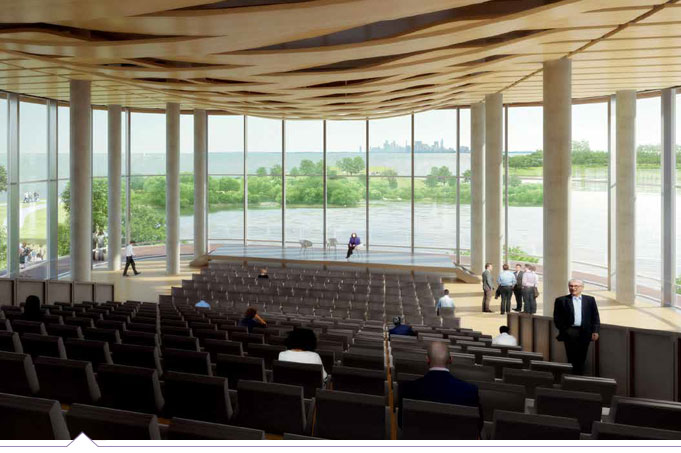 The two-story, 6,600-square-foot Conservatory is poised to become a signature convening space for both Kellogg and Northwestern. Embodying flexibility, the Conservatory will be able to host dinners for 250 or world-class lectures for 350.
The two-story, 6,600-square-foot Conservatory is poised to become a signature convening space for both Kellogg and Northwestern. Embodying flexibility, the Conservatory will be able to host dinners for 250 or world-class lectures for 350.Construction should be completed by late 2016, though classes will begin the following winter quarter. The class of 2017 will be the first full-time students to occupy the new, yet-to-be named building home.
As for Jacobs, some current Kellogg staff will remain while off-campus Kellogg groups will move into the space, Paul says. Northwestern will also move some of its departments there, vacating several of the houses that line Sheridan Road near the south campus. Norris may also adopt the atrium space.
And still, the new building has room to grow, and will continue to house Kellogg and its ever-evolving curriculum for decades to come. "You never know what could happen," Nayler says, "but we believe that this building can meet Kellogg's needs for a good 40 years."
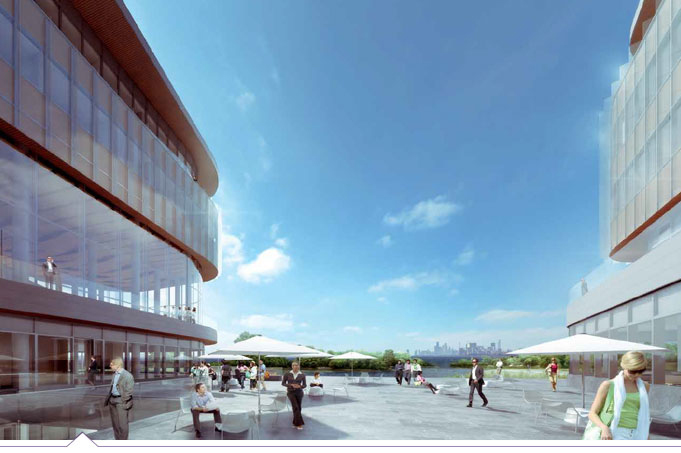
Designed with the spirit of openness, light and energy, the campus will welcome business and civic leaders from across sectors, age groups and the globe.
Combining the Allen Center with the global hub, Kellogg’s 600,000-square-foot business campus will sit along Lake Michigan, offering sweeping views from all sides, including Chicago’s vibrant skyline.